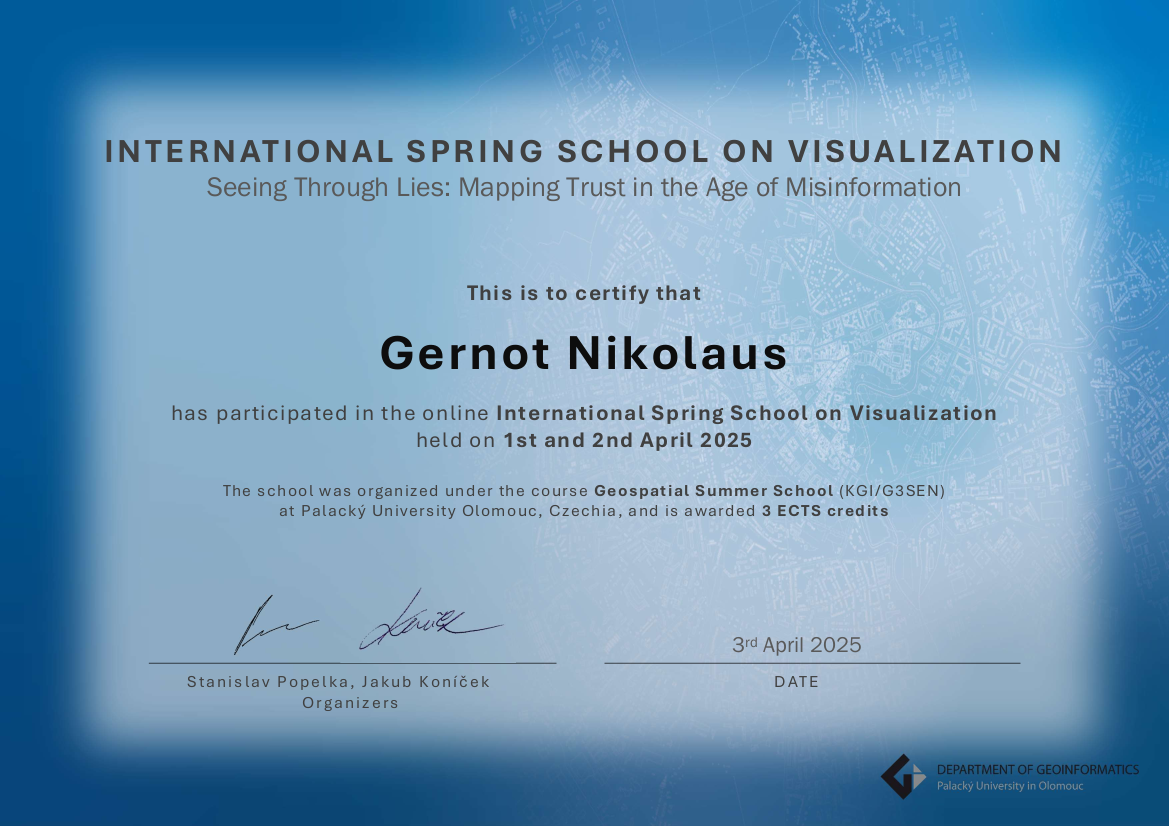Report on the International Spring School on Visualization: Seeing Through Lies: Mapping Trust in the Age of Misinformation
April 03, 2025
In April 2025 I had the chance to take part in the International Spring School on Visualization: Seeing Through Lies: Mapping Trust in the Age of Misinformation. This online event focused on innovative approaches to mapping trust, analyzing the spread of false narratives, and fostering critical thinking through data-driven visual storytelling. Speakers from around the world, including Czechia, Germany, Isreal, Slovakia, the US, and Vienna were ready to give us workshops, lectures, and discussions rounds, and to develop skills and tools for navigating the complex landscape of trust and truth in the digital age.
Day 1
The event began with a welcome from the organizers at 11:30. The first session was led by Georg Gartner, who spoke about what makes us trust a map and how important reliable maps are in our daily lives. Nili Steinfeld then introduced the idea of using eye-tracking technology to understand how we read digital maps. Her presentation made it clear that the way we look at a map can reveal a lot about our understanding of the information. Jakub Lysek then led us through a thought-provoking discussion on how maps can be manipulated, especially when it comes to the representation of electoral data. His talk showed us the potential for data distortion and the importance of honest mapmaking. Ian Muehlenhaus then shared his insights on how maps can be used to support political narratives, showing us that maps are not just neutral tools - they can shape opinions and influence society. Later, Petra Hypsova brought a unique perspective by exploring the connection between our personality and the way we look at maps. Her talk blended psychology and cartography in a very accessible way. The day concluded with Timothy Prestby’s talk on the science of trust and deception in maps, which gave us much food for thought about how we process and trust visual information. The day ended at around 7 o’clock.

Day 2
The second day began with a brief introduction by the organizers, again at 11:30. Eric Losang and Francis Harvey led a session on the ethics of mapmaking. They discussed the responsibilities of those who create maps and emphasized the importance of accuracy and fairness in the presentation of data. Next, Gabriela Godišková spoke about how charts can be designed to mislead us. Afterwards, Alena Vondráková led a practical workshop where we could work directly with map visualization. In this practical session, we were able to recognize common mistakes in map design and how to visualize appealing maps. Robert Moro then discussed the role of artificial intelligence in the spread of disinformation through maps. He explored how artificial intelligence can both create and combat false information. The day continued with a team session. This practical group work gave all participants the opportunity to put what they had learned into practice and work together to solve real challenges related to map design and data presentation. The color, the size of the charts and the context were misleading and also difficult to understand overall. We investigated these issues and made suggestions which we later presented to the whole group. This breakout session in the group was nice as we did not really have the chance to talk to the other people before and so now we could also exchange ideas, get to know each other, and share our background. After the long day, the event finished at around 7 o’clock.
